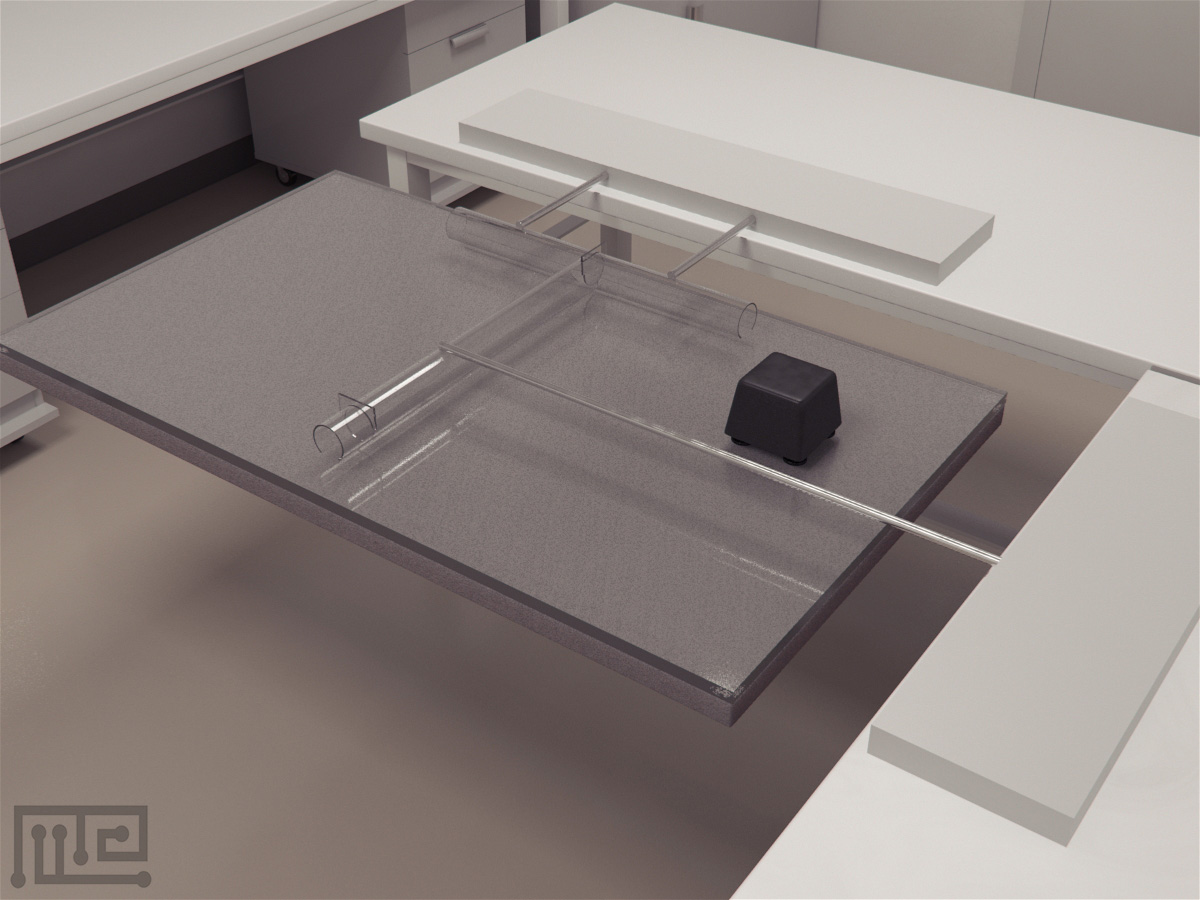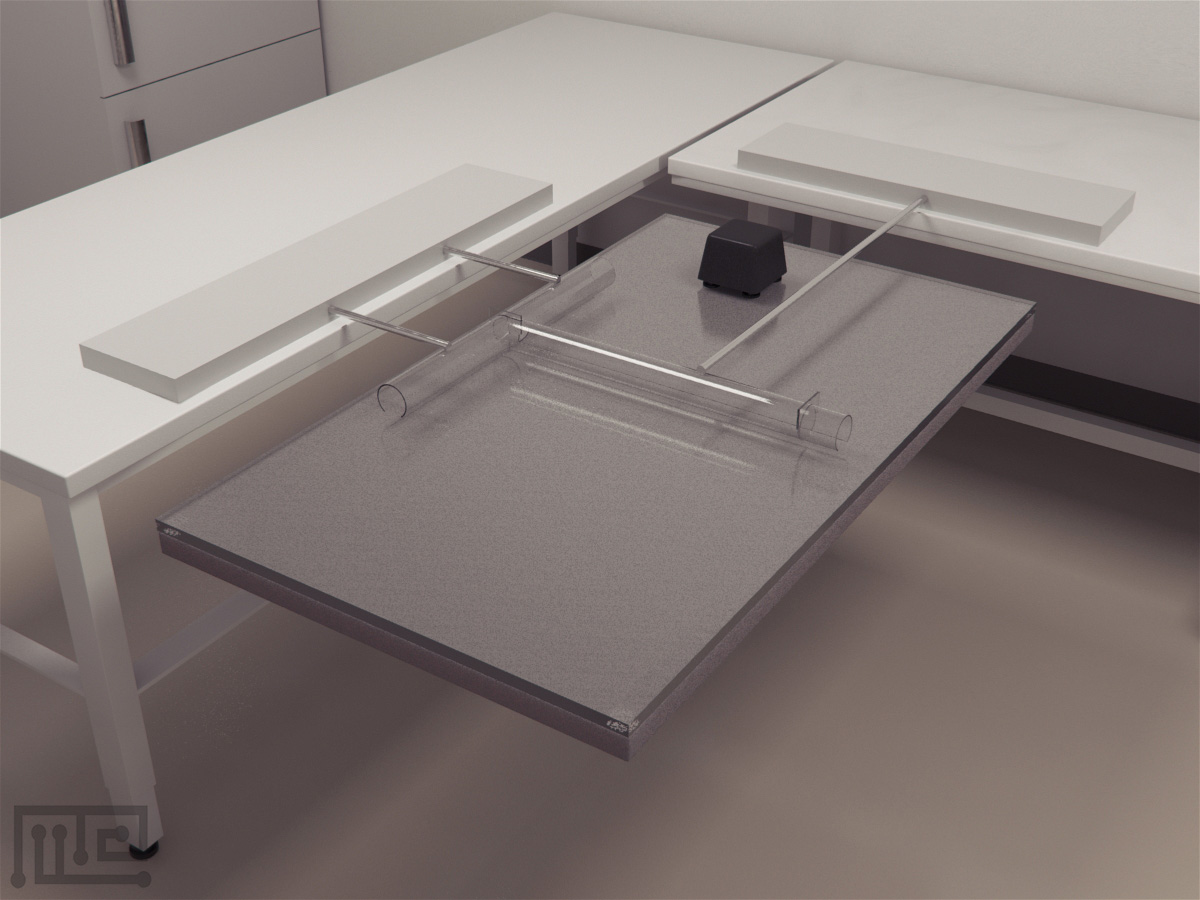Product Description
The Suspended T-Maze is used to assess spatial orientation. It was created by Tali Kimchi et al. (2004), in an experiment to check the evidence of the use of reflected self-generated seismic waves for spatial orientation in a blind subterranean mammal(mole-rat).
The maze consists of two transparent Perspex tubes joined to form a T-maze comprising a long entrance tube with two movable doors, one near the entrance and the second half way along, intersecting another perpendicular tube in the middle. A slit is cut out along the entire length of both tubes to ensure that the seismic signals would be transferred only to the paws of the subject via the maze floor.
Mazeengineers offer the Suspended T-maze. Custom coloring and customization are available upon request.
Price & Dimensions
Suspended T-Maze
$ 2490
+S&H- Length of acrylic board: 140cm
- Width of acrylic board: 80cm
- Heigth of acrylic board: 2cm
- Thickness of sponge: 4cm
- Diameter of transparent Perspex tubes: 6cm
- Length of entrance tube: 60cm
- Length of perpendicular tube: 50cm
- Width of slit cut out along the entire length of both tubes: 3.5cm
- Heigth of maze above acrylic board: 1cm
Documentation
Introduction
The Suspended T Maze is an adaptation of the popular T maze designed to assess spatial orientation in fossorial mammals. Fossorial mammals like blind mole rats orient in their underground habitat by using the mechanism of seismic echolocation (Kimchi, Reshef, & Terkel, 2005). They detect obstacles in their tunnel by generating low-frequency seismic waves generated by head drumming (Rado, Terkel & Wollberg, 1998). The waves reflect back from the obstacle and perceived through the somatosensory system of the mole rats (Heffner & Heffner, 1992). The Suspended T maze utilizes the subject’s tendency to perceive seismic signals through the paws of the subject (Kimchi, Reshef, & Terkel, 2005). It was first designed by Kimchi et al. (2005) to understand seismic echolocation for spatial orientation in mole rats.
The Suspended T Maze is composed of two transparent acrylic tubes linked perpendicularly to create a “T” shaped apparatus. The apparatus comprises a long entrance tube with two movable doors. One door is present at the entrance, and the other door is present in the middle of the perpendicular tube. A slit is cut out along the entire length of both tubes to allow seismic signals to travel only towards the paws of the subject through the maze floor. The subject chooses the arm with a vibrational signal by sensing the seismic signals through its paws. The Suspended T Maze can be used to investigate other behaviors like long-distance communication, foraging, and hazard avoidance in fossorial mammals.
Other T mazes used for behavioral assessments in rodents include the Continuous Angled T Maze, the Two Problem T Maze, the Elevated T Maze, the Light Dark T Maze.
Apparatus and Equipment
The apparatus consists of two transparent acrylic tubes (6 cm in diameter) joined perpendicularly to create a “T” shaped apparatus with one entrance tube and a perpendicular tube. The entrance tube (60 cm in length) is provided with one door at the entrance and other at the mid of the perpendicular tube (50 cm in length), creating two choice arms. The apparatus is suspended 1 cm above the acrylic board (140 cm in length x 80cm in width x 2 cm height) placed on a layer of 4 cm thick sponge. There is a 3.5 cm wide slit cut out along the length of each tube that allows the subject to move in the apparatus with their feet on the acrylic board. The apparatus is also provided with two additional acrylic tubes measuring 6 cm in diameter and 30 cm in length. Each tube is sealed from one end and contains a movable door at the other end. These tubes can be attached at each end of the perpendicular tube with a sealed end facing towards the perpendicular tube. The apparatus is also provided with a mini shaker to induce seismic waves in the acrylic board. Each arm of the maze is attached with a clamp to support the apparatus with adjoining tables.
Training protocol
Thoroughly clean the apparatus before each trail. Before carrying out the experiment, keep the subjects in 14 hours daylight to 10 hours dark regime at room temperature. Provide subjects with food ad libitum. For the head drumming task, attach additional acrylic tubes at each end of the perpendicular tube to place stimuli animal. An automated tracking and recording system such as the Noldus Ethovision XT can be used to assist with the observations.
Pretraining
Place the subject at the entrance of the apparatus. Open both doors and allow the subject to explore the maze freely for 15 minutes. Repeat this for 4 consecutive days. Now conduct a pretraining session by placing the subject at the maze entrance. Open both doors and allow the subject to move towards the T junction and make a choice between left or right arm provided with food rewards. After receiving the reward, remove the subject through an acrylic tube and place it back to its home cage. Conduct 10 pretraining sessions per day for 3 consecutive days.
Head drumming task
Open the entrance door of the apparatus. Introduce the subject into the entrance tube of the apparatus with the help of a transfer tube. Now close the entrance door behind the subject. At this stage, the subject is facing a T junction with a closed door and an entrance door behind the subject. Now place the stimulus animal in the right or left additional acrylic tube. Allow the stimuli animal to generate seismic waves by head drumming. After a few seconds of head drumming, open the door at the junction and allow the subject to choose between left or right arm. Conduct 20 trails/day on each subject for two consecutive days.
Mechanical shaking task
Open the entrance door of the apparatus. Introduce the subject into the entrance tube of the apparatus with the help of a transfer tube. Now close the entrance door behind the subject. Place mechanical shaker 15 cm away from one of the perpendicular tubes opening of the Suspended T Maze. After a few seconds, open the door at the junction and allow the subject to choose between left or right arm. Conduct 20 trails/day on each subject for two consecutive days.
For control trails, place stimuli source i.e., mechanical shaker or stimulus animal to the left or right of the perpendicular tube at 10 cm distance away from the corner of the central table on which the Suspended T Maze is placed. Allow the subject to choose between right or left arm.
Literature Review
Investigation of seismic echolocation for spatial navigation in Spalax ehrenbergi L
Kimchi et al., 2004 investigated seismic echolocation for spatial navigation in blind mole rats (Spalax ehrenbergi L). A field test was conducted to investigate characteristics of seismic waves generated by blind moles rats during tunnel making process. Two different experiments were performed in the field test. In the first experiment, 7-mole rat tunnels were identified above the ground. Each tunnel was disconnected by creating a rectangular ditch dividing the tunnel into two disconnected parts. In the control experiment, 5-mole rat tunnels were identified that were not provided with any obstacle. Seismic waves were recorded during the whole process of digging and detouring process with the help of the geophone array. A behavioral test was also conducted to find out if blind mole rats are able to perceive seismic waves through the somatosensory system and localize the source. Animals (n=14) were trained in the Suspended T maze and divided into two groups, group 1 (n=7) was exposed to seismic stimuli by a stimuli mole rat, and group 2 (n=7) was exposed to seismic stimuli from the mechanical shaker. Control experiments were also carried out on both groups of mice to look for the effect of surrounding stimuli in the absence of seismic stimuli.
Results of the field study revealed that all the monitored mole-rats produced low-frequency seismic waves of 250–300·Hz. 198±15 seismic waves were generated per meter of bypass tunnel burrowed by the mole rats with an interval of 8±5seconds (ranging from 1–13·s) between each head drums. Control mole-rats (5) generated significantly less seismic waves/meter (95±12 min–1) compared to mole rats burrowing a bypass tunnel (198±15·taps·min–1). Results of the behavioral test indicated that moles rats from both groups were able to successfully detect seismic waves through their paws. The mean success rate for choosing the arm with mechanical shaker stimuli was 85+1.5% for day 1 and 89+2.3% for day 2. The mean success rate for choosing the arm with mole rat stimuli was 94.3+2% for day 1 and 95.1+1.5% for day 2. The success rate of the subjects exposed to stimulus mole rat’s vibration was significantly better than that of the stimulus generated by the mechanical shaker (P<0.01). The results of histological examinations revealed the presence of lamellate corpuscle mechanoreceptors in the paws of the blind mole rat that can be a possible means to detect low-frequency seismic waves. The results concluded that mole rats use seismic echolocation to detect obstacles in the tunnels and perceive these seismic signals with the help of paws through the somatosensory system.
Data analysis
- Number of times each subject selects arm with vibrational source
- Number of times each subject selects arm without vibrational source
- Success (%) of each subject in selecting the arm with vibrational source
- Number of errors
- Time spent in each arm
- Time taken to complete a trial
Strengths and Limitations
Strengths
The Suspended T Maze is effective in understanding spatial orientation in rodents. The presence of moveable doors assists in controlling the movement of the subjects in the maze. Both mechanical and natural seismic stimuli can be generated using this apparatus. The maze can also be utilized to investigate other behaviors like communication, foraging behavior, and hazard avoidance in burrowing animals.
Limitations
The Suspended T maze apparatus exhibits complex design compared to the conventional T maze. The task performance in the Suspended T maze task is time-consuming. Excessive pretraining is required before task performance. Repeated handling may cause stress to the subject. The presence of unsolicited stimuli may alter task performance.
Summary
- The Suspended T Maze is a modified T Maze designed to understand spatial orientation in fossorial mammals.
- It consists of two Acrylic tubes joined perpendicular to each other to form a “T” shaped apparatus suspended above an acrylic board.
- Both mole rat head drumming and mechanical vibrations can be introduced in this apparatus.
- The Suspended T Maze allows subjects to detect seismic waves through its paws chooses choice arms with the vibrational stimuli.
- The task performance is easy but time-consuming.
- The Suspended T Maze can also be used to understand communication, foraging, and hazard avoidance in fossorial mammals.
References
- Heffner, R. S., & Heffner, H. E. (1992). Hearing and sound localization in blind mole rats (Spalax ehrenbergi). Hearing research, 62(2), 206–216. https://doi.org/10.1016/0378-5955(92)90188-s
- Kimchi, T., Reshef, M., & Terkel, J. (2005). Evidence for the use of reflected self-generated seismic waves for spatial orientation in a blind subterranean mammal. The Journal of experimental biology, 208(Pt 4), 647–659. https://doi.org/10.1242/jeb.01396
- Rado, R., Terkel, J., & Wollberg, Z. (1998). Seismic communication signals in the blind mole-rat (Spalax ehrenbergi): electrophysiological and behavioral evidence for their processing by the auditory system. Journal of comparative physiology. A, Sensory, neural, and behavioral physiology, 183(4), 503–511. https://doi.org/10.1007/s003590050275
Request a quote
"*" indicates required fields


